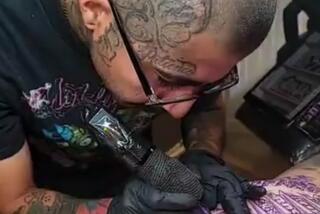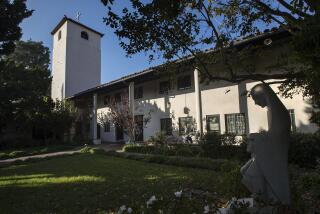Weaving a Fabric of Faith With Tapestries
OJAI — John Nava says that his most famous artwork is the “Dump Weldon” bumper sticker that adorned so many Ojai Valley cars in the early 1990s in a campaign that quashed plans to build a landfill in Weldon Canyon.
In the fall of 2001, though, the Ojai artist will be celebrated for works displayed in a much more distinguished setting than the back of a Buick. More than 30 of his tapestries will hang inside the new Cathedral of Our Lady of the Angels in downtown Los Angeles.
It’s the commission of a lifetime.
“It’s very easy to do work that’s minor, but every once in a while you come across something incredible,” said Nava, 52. “That’s a possibility.”
Nava and the Roman Catholic Archdiocese of Los Angeles finalized their agreement this week, Nava said. Neither he nor church representatives would reveal the price.
Nava’s tapestries of the Communion of Saints will be the only art, other than functional pieces like the cross and altar, in the central part of the $163-million headquarters for Catholics from Los Angeles, Ventura and Santa Barbara counties, said Father Richard Vosko, the liturgical and public art consultant for the project.
“This will be the largest collection of tapestries in the world,” Vosko said.
Nava didn’t even know of the planned cathedral when a letter arrived in the summer of 1998 saying that he was one of several hundred artists being considered to work on the project. Linda Ekstrom, a Santa Barbara artist on the archdiocese’s art and furnishings committee, had suggested consideration of her longtime friend because of his skill at drawing and painting the human figure.
Nava had studied art at UC Santa Barbara and reveled in the works of Michelangelo and Leonardo da Vinci while earning his master’s degree in fine art in Florence, Italy.
He taught art at universities for 12 years before dedicating himself full-time to working as an artist, primarily in figurative oil paintings.
After Nava was named a finalist for the cathedral job last fall, he began working in earnest on the project.
Church planners originally discussed sandblasting or etching images of saints into the walls, but acoustical problems necessitated a change to sound-absorbing tapestries. Nava researched the use of computers for transferring art to tapestries and made sketches of the saints using friends and family members as models.
The archdiocese awarded Nava the commission in April and work on details of the agreement continued until this week. Vosko said Nava was chosen not only because he is a wonderful artist, but also because he had the technical knowledge to produce the tapestries.
Nava also intrigued planners with his ideas for portraying 133 larger-than-life-size saints. His novel approach complemented the originality of the building’s design, which includes translucent alabaster-lined windows and an angling of the entire structure to catch maximum sunlight.
“I think it’s really quite stirring and very unique,” Ekstrom said of Nava’s plan for the tapestries.
Nava proposed to portray popular saints like Peter and Mary Magdalene with modernized appearances, and to include lesser-known saints and unknown people of all groups represented in the archdiocese.
Nava will draw and paint heads, bodies and hands separately. Then he will scan the images into a computer, group them together and manipulate the colors, and the digitized images will be sent to an electronic loom.
Tapestries have never been created this way, so Nava is developing a new process.
“It’s rare nowadays to do a painting of humans that is not ironic, sardonic, sarcastic or tongue-in-cheek,” Nava said. “It is a great thing to paint a really affirming, beautiful, hopeful image of humans.”
More to Read
The biggest entertainment stories
Get our big stories about Hollywood, film, television, music, arts, culture and more right in your inbox as soon as they publish.
You may occasionally receive promotional content from the Los Angeles Times.










